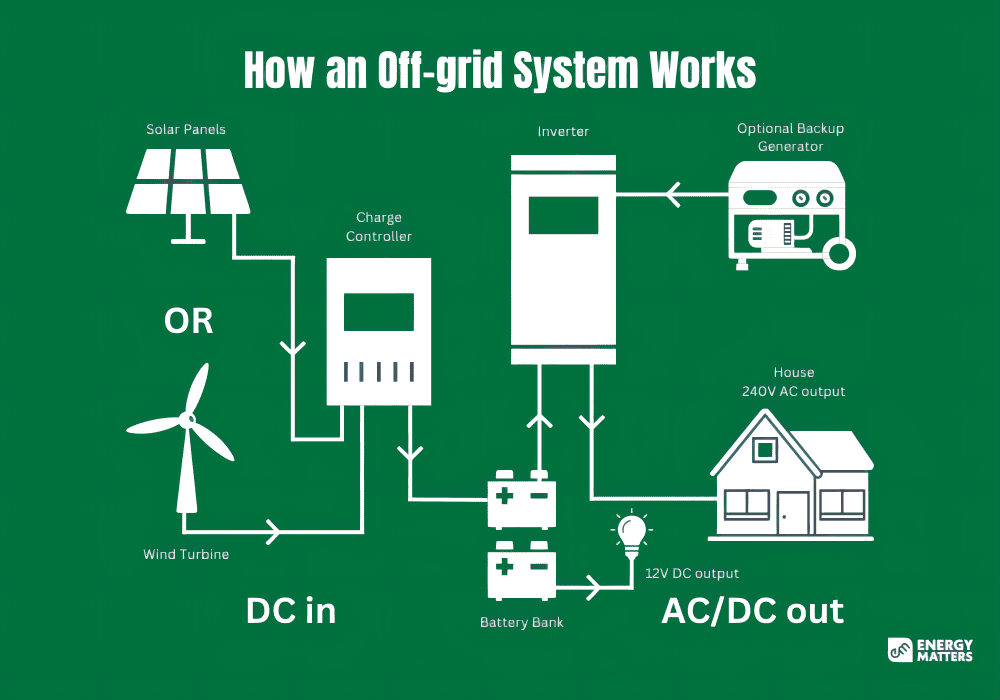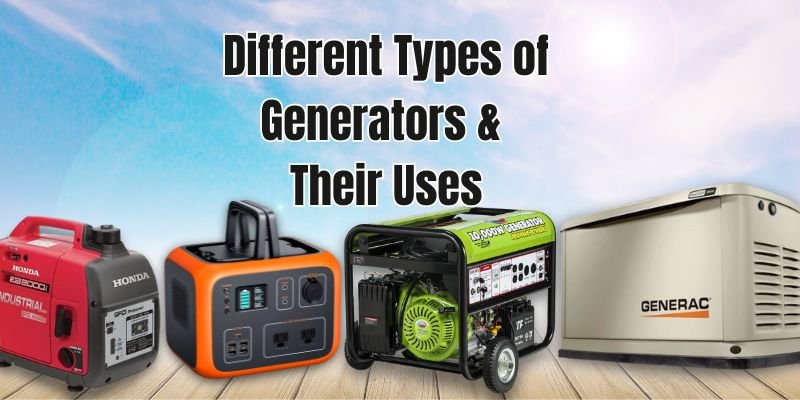Disclosure: This post contains affiliate links and I will be compensated if you make a purchase after clicking through my links. Learn More
Off-grid power is energy that operates independently from the main power grid. It uses renewable sources like solar, wind, or hydro power.
Living off-grid has become a popular choice for many. People seek self-sufficiency and a smaller environmental footprint. Off-grid power systems provide electricity without relying on public utilities. This can be crucial for remote areas where grid access is limited. It also offers a sense of independence and resilience.
Whether you want to save on utility bills or live sustainably, off-grid power can be a great solution. In this post, we will explore what off-grid power is and how it works. Let’s dive in and understand this alternative energy source better.

Credit: www.namkoosolar.com
Off Grid Power Basics
Off grid power means generating electricity independently from the traditional power grid. It often uses renewable sources like solar or wind. This system is ideal for remote areas or eco-friendly living.
Off-grid power is an intriguing concept, especially for those who crave independence and sustainability. Imagine living in a place where you’re not dependent on the local utility company for your energy needs. It’s about creating a self-sufficient lifestyle, whether you’re in a remote cabin or a suburban home. Let’s dive into the basics of off-grid power, unraveling its core definition and the benefits of energy independence.Definition And Concept
Off-grid power refers to systems that operate independently from the traditional electrical grid. These systems rely on renewable energy sources like solar panels, wind turbines, or even micro-hydropower to generate electricity. The goal is to produce enough energy to meet your needs without tapping into public utilities. A key component of off-grid systems is energy storage, typically through batteries. This ensures you have power available even when the sun isn’t shining or the wind isn’t blowing. The concept might sound complex, but many find the challenge rewarding. Crafting a self-reliant power setup can be empowering and fulfilling.Benefits Of Independence
One of the primary benefits of off-grid power is energy independence. You’re not subject to power outages that affect traditional grid users. This can be crucial in areas prone to natural disasters or unreliable utility services. Financial savings are another advantage. While the initial setup can be costly, over time, you can save money on utility bills. Many people find joy in watching their energy bills shrink month by month. Lastly, an off-grid lifestyle can align closely with environmental values. By using renewable energy, you reduce your carbon footprint. This approach can make a significant impact on the environment, offering a sense of personal responsibility and accomplishment. Have you ever considered how much control you could gain by producing your own power? Imagine the satisfaction of knowing your electricity comes straight from the sun or wind, powering your life on your terms.
Credit: www.offgridenergy.com.au
Types Of Off Grid Systems
Understanding different types of off-grid systems can empower you. These systems provide energy independence and sustainability. Off-grid solutions vary widely, from solar panels to wind turbines. Each offers unique benefits and challenges. It’s crucial to know how each system works. This knowledge helps you choose the right one for your needs.
Solar Power Solutions
Solar power is a popular off-grid option. Panels convert sunlight into electricity. This electricity powers homes and devices. Solar systems can reduce reliance on traditional energy sources. They are often easy to install and maintain. Additionally, solar power is clean and renewable. It helps reduce carbon footprints. Even in cloudy areas, solar can be effective. Battery storage enhances solar system efficiency. Storing energy for cloudy days or nighttime use is vital. Solar panels come in various sizes and types. Choose based on space and energy needs.
Wind Energy Options
Wind energy is another off-grid choice. Turbines harness wind to generate electricity. Wind systems are ideal in windy locations. They complement solar power well. Wind energy is sustainable and eco-friendly. It reduces dependency on fossil fuels. Installing wind turbines requires careful site assessment. Consider wind speed and direction for optimal performance. Maintenance is crucial for long-term efficiency. Wind turbines vary in size and capacity. Smaller systems suit residential use. Larger ones can power entire communities.
Key Components
Off-grid power systems are becoming more popular as people seek energy independence. Understanding the key components is crucial. These components ensure the system works efficiently and reliably. Let’s explore the main parts that make up an off-grid power system.
Batteries And Storage
Batteries store energy produced by solar panels or wind turbines. They provide power when renewable sources aren’t available, like at night or during cloudy days. The battery type and capacity are vital. They determine how long you can rely on stored energy.
Lead-acid and lithium-ion are common battery types. Lead-acid batteries are affordable but heavy. Lithium-ion batteries are lighter and last longer. Proper storage also extends battery life. Keep them in a cool, dry place.
Inverters And Controllers
Inverters convert the DC power from batteries to AC power. Most home appliances run on AC power. Without an inverter, you can’t use your stored energy. There are two main types of inverters: pure sine wave and modified sine wave. Pure sine wave inverters are more efficient and compatible with all devices.
Controllers manage the energy flow from your renewable sources to the batteries. They prevent overcharging and extend battery life. The most common type is the Maximum Power Point Tracking (MPPT) controller. MPPT controllers are efficient and maximize energy harvest.

Credit: www.youtube.com
Installation Process
Setting up off grid power involves installing solar panels or wind turbines. These systems store energy in batteries for later use.
When you decide to go off-grid and generate your own power, the installation process is a crucial step. It’s where dreams meet reality, and your sustainable lifestyle begins to take shape. Navigating the installation process effectively ensures that your off-grid power system not only meets your current needs but also adapts to future demands.Site Assessment
The first step in the installation process is a thorough site assessment. This is where you determine the best location for your solar panels or wind turbines. Consider factors like sunlight exposure, wind patterns, and proximity to your home. Visit the site at different times of day to understand how shadows from trees or buildings might impact your energy collection. An accurate assessment helps avoid costly mistakes and ensures maximum efficiency. Visualize your future self sitting on the porch, knowing that every sunbeam is powering your home. Isn’t that worth a little extra time and effort now?System Setup
Once you’ve completed the site assessment, it’s time to set up the system. This involves installing solar panels, wind turbines, batteries, and an inverter. Start with the solar panels, ensuring they are securely mounted and angled correctly. This can be a fun weekend project, turning what seems like a daunting task into a rewarding experience. Next, install the batteries in a safe, dry location. Connect them to the inverter, which converts the energy into usable electricity. Double-check all connections to avoid future issues. Imagine the peace of mind knowing your lights will turn on, even when the grid is down. Are you ready to enjoy your newfound independence?Cost Considerations
Switching to off grid power is a significant decision. Understanding the costs involved is crucial. From initial investments to potential savings, each aspect plays a vital role. Let’s delve into these cost considerations.
Initial Investment
Setting up off grid power demands upfront expenses. Solar panels and wind turbines are common choices. Each has its own price range. Equipment quality affects initial costs. Installation charges also vary. Professional help may be required. This adds to the total cost. Battery systems are another consideration. They store energy for later use. High-quality batteries can be pricey. Initial investment can be substantial. But it lays the foundation for future savings.
Long-term Savings
Off grid power offers long-term financial benefits. Monthly electricity bills become a thing of the past. Maintenance costs are relatively low. Solar panels have a long lifespan. Wind turbines require minimal upkeep. Energy independence is achieved. No reliance on utility companies. This ensures stable energy prices. Over time, savings accumulate significantly. Initial costs are offset by these savings. Environmental benefits add value too. Off grid power is sustainable. Lower energy consumption reduces carbon footprint. Contributing to a healthier planet.
Maintenance Essentials
Off-grid power means generating electricity without relying on traditional utility grids. People often use solar panels, wind turbines, or generators for this. It offers independence and sustainability, especially in remote areas.
Maintaining an off-grid power system is crucial for its longevity and performance. You wouldn’t want to be caught without power when you need it most. Whether you’re using solar panels, wind turbines, or a combination of both, regular maintenance can prevent unexpected hiccups and ensure your system runs smoothly. Here’s a guide to help you keep your off-grid power system in top shape.Routine Checks
Regular inspections are your first line of defense against potential issues. Start by examining your solar panels or wind turbine blades for any physical damage. Look out for cracks or debris that might obstruct their efficiency. Check the battery connections and wiring. Ensure they’re secure and free from corrosion. A simple wipe with a baking soda solution can keep corrosion at bay. Test your system’s output periodically. Does it match the expected performance? If not, it might be time to dig deeper. Keeping a log of these checks can help you track patterns and anticipate future needs.Troubleshooting Tips
When issues arise, a systematic approach can save you time and effort. Begin by isolating the problem. Is it a power drop, a strange noise, or perhaps a complete shutdown? Inspect the charge controller. Sometimes, resetting it can resolve minor glitches. Make sure it’s displaying correct readings and settings. If the issue persists, check the inverter. Listen for unusual sounds or check for error messages. A loose connection might be the culprit, or a fuse may need replacing. Sometimes, the simplest solution is the most effective. A personal story comes to mind: my solar system once stopped charging, and I almost called in an expert. It turned out a branch was casting a shadow over the panels. A quick trim of the tree restored full function. Have you ever faced a sudden power outage in your off-grid setup? What steps did you take to resolve it? Share your experiences and insights in the comments to help others in the community.Challenges And Solutions
Off grid power means using energy sources not connected to the main electric grid. This can be hard due to equipment costs and weather changes. Solutions include solar panels, wind turbines, and battery storage to provide reliable energy in remote areas.
Off-grid power offers freedom from traditional energy sources. But it comes with challenges. Understanding these challenges helps in finding effective solutions. Let’s explore the main hurdles and ways to overcome them.Weather Impacts
Weather can greatly affect off-grid power systems. Solar panels need sunlight to work well. Cloudy days reduce energy production. Heavy rain or snow can cover panels, blocking sunlight. Wind turbines rely on steady winds. Calm days limit their energy output. Energy storage becomes crucial during these times. Battery systems store extra power for use when weather conditions are poor. Regular maintenance ensures panels and turbines are free from debris. Smart planning considers local weather patterns. This helps in choosing the right energy sources and storage solutions.Technical Limitations
Technical issues can disrupt off-grid systems. Equipment can fail or wear out over time. High-quality components reduce the risk of breakdowns. In remote areas, replacing parts can be difficult. Keeping spare parts on hand is wise. System monitoring is essential. It detects problems before they escalate. Users must learn basic troubleshooting skills. This knowledge helps in handling minor issues quickly. Regular system checks prevent major failures. Investing in reliable technology ensures consistent energy supply.Future Of Off Grid Power
The future of off-grid power is a fascinating topic. As technology evolves, off-grid solutions become more efficient and accessible. People are seeking alternatives to traditional energy sources. Off-grid power offers autonomy and sustainability. It’s an exciting area with many developments.
Technological Advancements
New technologies are reshaping off-grid power systems. Solar panels are more efficient than ever before. Energy storage solutions have improved dramatically. Batteries now store more energy for longer periods. Wind turbines are becoming smaller and more effective. These advancements make off-grid living practical and appealing.
Innovative solutions keep emerging. Smart grids and IoT devices optimize energy use. They predict power needs and adjust supply. This means less waste and more reliable power. Tech innovations enhance off-grid systems daily.
Sustainability Trends
There’s a growing focus on sustainability. Renewable energy sources are key to off-grid power. Solar and wind power reduce reliance on fossil fuels. These sources are clean and abundant. They minimize environmental impact.
People are more aware of their carbon footprint. Off-grid power aligns with eco-friendly values. Sustainable energy solutions attract attention from conscious consumers. They want energy independence without harming the planet.
The future is bright for off-grid power. As society values sustainability, off-grid solutions gain popularity. People see the benefits and embrace change. This trend supports a greener future for all.
Frequently Asked Questions
How Does Off-grid Power Work?
Off-grid power works by generating electricity independently from the main grid. It uses renewable sources like solar panels, wind turbines, or hydroelectric systems. Batteries store excess energy for use when production is low. This system provides energy self-sufficiency and is ideal for remote locations without grid access.
What Are The Disadvantages Of Off-grid Electricity?
Off-grid electricity systems can be expensive to install and maintain. Energy storage solutions like batteries have limited lifespans. Power supply can be inconsistent due to weather conditions. Regular maintenance is required to ensure system efficiency. Remote locations may face difficulties in accessing technical support.
What Does “off The Power Grid” Mean?
“Off the power grid” means living without reliance on public electricity. It involves generating your own power, often through solar panels, wind turbines, or generators. This lifestyle promotes self-sufficiency and may reduce energy costs and environmental impact. It’s popular among eco-conscious individuals and those in remote areas.
What Does Off-grid Power Supply Mean?
An off-grid power supply means generating electricity independently from the main grid. It typically uses solar panels, wind turbines, or generators. This system is ideal for remote areas or sustainable living.
Conclusion
Off grid power offers independence and sustainability. It provides energy without relying on the grid. This means more control over your power needs. Also, it reduces electricity bills. Off grid systems use renewable sources like solar and wind. These are clean and eco-friendly.
They help decrease carbon footprints. For those seeking self-sufficiency, off grid power is a smart choice. It can be tailored to fit any lifestyle. Explore off grid power and enjoy a greener future.


